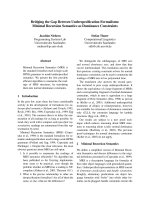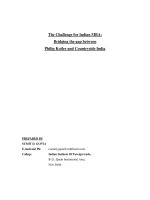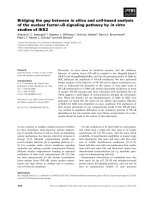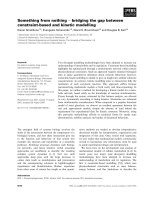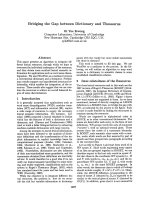The Challenge for Indian MBA: Bridging the gap between Philip Kotler and Countryside India potx
Bạn đang xem bản rút gọn của tài liệu. Xem và tải ngay bản đầy đủ của tài liệu tại đây (121.58 KB, 18 trang )
The Challenge for Indian MBA:
Bridging the gap between
Philip Kotler and Countryside India
PREPARED BY
SUMIT D. GUPTA
E-mail and Ph: ()
College: Indian Institute Of Foreign trade,
B-21, Qutab Institutional Area,
New Delhi.
2
Executive Summary
“India’s way is not Europe’s. India is not Calcutta and Bombay. India lives
in her seven hundred thousand villages.” Mahatma Gandhi, 1926
Marketing in developing countries like India have often been borrowed from the western
world. Concepts like Brand identity, Customer relationship management, 4 P’s of the
marketing mix, Consumer behaviour process; Segmentation, targeting and positioning
etc. have often been lifted straight from the marketing intelligentsia abroad and adopted
in Indian conditions, often with minimal success. Reason lies not in the fault of such
concepts, but their integration with the Indian ethos and culture.
The rural India offers a tremendous market potential. Nearly two-thirds of all middle-
income households in the country are in rural India and represents half of India’s buying
potential. Despite, the strong potential the rural markets are by and large less exploited.
Consider the market, out of five lakh villages in India only one lakh have been tapped so
far. According to us if the rural market has to be adequately tapped, there has to be a
change in the way marketing concepts learnt in B-schools with adequate adoption
according to scenarios prevalent in rural India. The paper thereby present the modified
version of Philip Kotler’s famous marketing mix consisting of 4P’s. The focus is on its
modification and subsequent customization to Indian rural market’s perspective. The 4
P’s have to be modified to include 1P i.e. Packaging and 1R i.e. Retailer as special focus
areas. Further to ensure the sustainability of the marketing mix two E’s i.e. Education and
Empowerment have to be at the core as they help in generating widespread participation
from the rural clientele by enhancing their standard of living.
The Products in the rural market should essentially operate at the basic and expected level
of product classification. They should essentially meet the basic needs of the consumer
and should be a no-frill product, as the consumer would not be valuing much any further
addition to the product concept. Companies also face a daunting task in communicating
about their products to the consumer due to lack of literacy and failure of traditional
media to penetrate in the rural households. Hence, the advertising mix has to be more
3
towards non-conventional yet effective medium like Puppetry, Folk Theater & Song,
Wall Painting, Demonstration, Posters, Agricultural Games, NGO’s network, etc. Thus
overall either the product or communication or preferably both need to be customized to
target the rural customer.
In terms of physical distribution due to lack of infrastructure the costs are very exorbitant
to reach the rural customer. Thus, mediums like rural marketing vehicles and melas and
haats provide better opportunities to meet customer needs. Also the existing distribution
would need a transformation to achieve the required penetration levels as success of
Project Streamline of HLL has shown. Since, the value for money concept is more
important rural customers, there has to be an approach of treating customer as budget
seeking consumer. Here, fitting the consumer needs into an affordable price point is
pursued first and then other features of product are fitted in. Similarly, packaging has to
meet customer needs of better brand recall and introducing favorable price points. At the
same time the importance of retailer has to be recognized where he is one of the most
major influencer is customer’s decision making process. He acts as the friend and guide
in this process and hence, needs to be managed effectively through promotion
programmes and incentives to promote the brand of a company.
In order to bridge the gap between Philip Kotler and countryside Indian what is needed
the appreciation of unique features of rural India and thus, responding to them by making
adequate improvements in the application of the marketing concepts learnt in the class.
For achieving the desired results of capturing the rural customer a comprehensive
approach to the traditional marketing concepts has to be taken. This marketing mix has to
be responsive to customer’s needs and fit into his life as a tool of self-enhancement. To
be successful the concept of marketing has to be taken in conjunction with its economic,
psychological and social implications.
4
Unique features of rural marketing in India
Marketing according to a leading management theories Peter Drucker can be put in this
way “The aim of marketing is to know and understand the customer so well that the
product or service fits him and sell itself."
We feel that the above quote is the gist of marketing, be it in rural areas or urban areas,
western world or developing world. Marketing in nothing but creating customers and thus
its concepts remain the same. But, due to the differences in the needs, buying behaviour,
values and aspirations of the customers the marketing concepts have to be modified to be
successful. The unique features of rural India which call for special attention and thus,
subsequent changes in the application of marketing concepts are as follows:
a) Traditional Outlook: The rural consumer values old customs and tradition. Basic
cultural values have not yet faded in rural India. Buying decisions are highly influenced
by social customs, traditions and beliefs in the rural markets.
b) Levels of Literacy: - The literacy rate is low in rural areas as compared to urban areas.
This comes in way of the marketer in promoting the product. Advertising is very
expensive making it difficult to communicate with the target audience.
c) Lack of Proper Communication and infrastructure facilities: - Nearly fifty percent
of the villages in the country do not have all weather roads. The Infrastructure Facilities
like roads, warehouses, communication system, financial facilities are inadequate in rural
areas making physical distribution becomes costly.
d) Many Languages and Dialects: - The number of languages and dialects vary widely
from state to state region to region and probably from district to district. Even though the
numbers of recognized languages are only 16, the dialects are estimated to be around 850.
e) Low Per Capita Income: - Even though about 33-35% of gross domestic product is
generated in the rural areas it is shared by 74% of the population. Hence the per capita
5
incomes are low compared to the urban areas. Normally the rural consumers spent a
majority of their income in basic necessities, which makes them very price sensitive.
The above points indicate the need for subsequent adoption of ‘Marketing principles’ as
propounded by Kotler and other management thinkers, with requisite changes suiting the
Indian Market. The marketing mix in the case of Indian rural markets consists of 4P’s i.e.
Product, Price, Promotion, Place combined with 1 P that is Packaging and one R i.e.
Retailer as special focus areas. However, at the base of this marketing mix will be 2 E’s
of Education and Empowerment.
The traditional marketing hypothesis tends to ignore the requirement of a developing
country’s rural needs. The concept of marketing has to be taken in conjunction with
economic, psychological and social implications. Hence, the concept of Mega-Marketing
where all such factors are taken into consideration while developing the Marketing Mix is
more relevant to succeed and build enduring brands. In rural India’s case the two most
important considerations are Education and Empowerment opportunities which
Product, Place, Price and Promotion
Packaging
Retailer
CUSTOMISATION
EDUCATION EMPOWEREMENT
The Marketing Mix for Rural India
6
traditional approaches of marketing fail to acknowledge. Then only the opportunity
provided by the rural market can be fully tapped. (SEE APPENDIX 1)
1. Product
“Authentic marketing is the art of identifying and understanding customer needs
and creating solutions that deliver satisfaction to the customers, profits to the
producers and benefits for the stakeholders.” Philip Kotler
The product offerings have to be not only customized but also at a different plane
altogether in case of rural markets. The various product levels as outlined by Philips
Kotler, namely Core Benefit, Basic Product, Expected product, augmented product and
Potential Product should be adequately taken into consideration and the product offerings
should be henceforth customized according to the needs.
Most of the times in the urban market the product is offered at the augmented product
level where the objective of the product offering is to exceed the customer expectation.
But in the rural markets of India which have been till date characterized by the absence
of the choice, sub-standard products and cheap clones of their urban counterparts; the
Core Benefit
Basic
Product
Expected
Product
Augmented
Product
Potential
Product
7
immediate level to be operated is the Expected product where his expectations are met.
Also, due to the low level of incomes and literacy levels, it is imperative that the basic
needs of the consumer are met. For e.g. Today, in India, 70 percent of the shampoo
market is in sachets. Forty percent of rural workers are daily wage earners and have a
daily purchase habit and could do so because of low unit price packs. In real terms
because of these packs, shampoos cost less than 14 years ago. Here the product is
meeting the basic level of need and providing the benefit of convenience and economy
without enthralling or overtly exceeding his expectation.
In case of durable goods the rural customers essentially look for a product that is frill-
free, sturdy and long lasting and in case of consumer goods he looks for products that
operate at the basic level and can provide additional benefits in synchronization with their
habits and lifestyle. For e.g. success of HLL in the soap category indicate the need to new
product development after listening to customer’s needs and not blindly applying the
urban solutions to rural problems. (SEE APPENDIX 2)
2. Promotion: Effective Communication
“If you're trying to persuade people to do something, or buy something, it seems to
me you should use their language, the language in which they think.”- David Ogilvy
Companies cannot rely on conventional advertising techniques in India’s rural areas
where only one in every three households owns a television set and more than half of all
villagers are illiterate. Instead, companies need to turn to more innovative methods of
advertising to reach their potential customer base. Also what appeals to the urban
customer may not appeal to the rural customer due to varying lifestyles. So again, even if
the media reaches him, there might not be an impact as it may fail to attract him as fails
to connect to it due to the lifestyles being different. Few of the available options in the
traditional media are
Puppetry,
Folk Theater & Song,
Wall Painting,
8
Demonstration, Posters,
Agricultural Games,
NGO’s network
The need for innovative means of communication in rural area can be appreciated by the
case study (SEE APPENDIX 3) where advertisement on hand pumps and ponds helped
in selling more soaps to rural customers.
Customization: Combining the above two points we would like to stress the need to
concentrate on both product development and communication in order to win the mind
space of the average rural Indian. Again a concept touted by the marketing gurus
regarding product and promotion strategies in International markets (analogy extendable
to domestic companies moving from urban to rural areas as well) can be used.
In order to achieve success company should avoid straight extension. Rather some form
of adaptation be it in preferably product or communication or both. In case of deep
pockets, product inventions suited for Indian conditions would be able to generate more
returns rather then a simple copied strategy from abroad or urban markets.
Product
Do not change Adapt Develop new
Product Product Product
Do not change
Promotion
Promotion
Adapt
Promotion
Straight
Extension
Product
Adaptation
Product
Invention
Communication
Adaptation
Dual
Adaptation
9
3. Place: Physical Distribution and Channel Management
For most companies wanting to enter the rural markets, distribution poses a serious
problem. Distribution costs and non availability of retail outlets are major problems faced
by the marketers. The various options in distribution in the rural markets, which will be
out of the ambit proposed traditionally by the marketing gurus would be:-
a.) Rural Marketing Vehicle (RMV) Marketers need to make more on- ground contact
with their target audience as well as make demonstration of products as consumers in
rural markets rely on the 'touch and feel' experience. One of the ways could be using
company delivery vans which can serve both the purposes.
b.) Melas and Haats:- According to the Indian Market Research Bureau, around 8000
melas are held in rural India every year and annual sales at melas amount to Rs.3,500
crore. Besides these melas, rural markets have the practice of fixing specific days in a
week as Market Days when exchange of goods and services are carried out. Also, every
region consisting of several villages is generally served by one satellite town where
people prefer to go to buy their durable commodities. Marketing managers can use these
feeder towns they will easily be able to cover a large section of the rural population.
The need for innovative distribution techniques to reengineer the existing distribution
processes can be appreciated by studying the Project streamline as used by HLL in
increasing its reach by adding sub-stockists in its existing distribution (SEE APPENDIX
4).
4. Pricing the product
A significant portion of the rural population is paid in daily wages. Daily wage earners
tend to have little stock of money, and therefore tend to make purchases only to meet
their daily needs. The implication is that pack sizes and price points are critical to sales,
and importantly, that rural consumers view the purchase-tradeoff dilemma across a much
wider range of product categories. As a result, the nature of competition is much greater;
a beverage manufacturer is not only competing with other manufacturers in its category,
10
but also other products that consumers may consider one-off luxury purchases such as
shampoo. So marketer will have to examine method by which he can make the product
more affordable. In the case of consumer durable one way is to work through rural bank
and offer higher purchase terms to consumer. In short, the Value for money is the most
important concept that will differentiate the successful brand from the rest.
As explained above in the diagram, a budget seeking consumer in the rural India, takes
into consideration first of all the budget available to him and then warranty and after sales
service before settling on the brand name and model. Thus, the concept of the product
fitting into one’s budget is most important consideration while making a purchase
decision.
5. The 5 the ‘P’ OF MARKETING- i.e. Packaging
The reason for putting packaging out of the product as a special focus area is that due to
low literacy levels the importance of symbols and packaging become more important in
having a high brand recall (SEE APPNDIX 5 for case on Asian Paints). Thus, after the 4
p of marketing, it is 5
th
P which is packaging going to play a key role in rural markets.
Also since the rural customers are usually daily wage earners and they don’t have
Brand Name
Model
Technology
Budget
Image
Budget
Warranty
After Sales
Model
Brand name
Status-seeking
Consumer
Budget-conscious
Consumer
11
monthly incomes like the ones in the urban areas have. So the packaging is in smaller
units and lesser-priced packs that they can afford given their kind of income streams.
(SEE APPENDIX 6 for smaller priced packages).
6. Retailer: The cog in the wheel
Data on rural consumer buying behaviour indicates that the rural retailer influences 35%
of purchase occasions. Therefore, sheer product availability can determine brand choice,
volumes and market share. So, role of retailer is also very important in rural markets,
because he would be one who provides information regarding quantity of pack,
promotional schemes, influences of advertisement, consumer feedback etc to company.
So the retailer plays a very big role here. The rural customer goes to the same shop
always to buy his things. And there is a very strong bonding in terms of trust between the
two. The buying behaviour is also such that the customer doesn't ask for the things by
brand but like "paanch rupey waali chaye dena". Now it is on the retailer to push
whatever brand he wants to push as they can influence the buyer very easily and very
strongly on the preferences. Hence, there is the need to get his support through proper
trade promotion activities to get more retail shelf and convincing on his side to make the
customer buy the brand.
M
M
a
a
r
r
k
k
e
e
t
t
i
i
n
n
g
g
F
F
a
a
c
c
t
t
o
o
r
r
s
s
RETAILER
Personal & Environmental Factors
12
The Core:
The two biggest problems that the rural India faces are Illiteracy and Unemployment. To
integrate them in one’s Marketing mix ensures that the product or service offered ensures
wider participation and better chances of success. Hence, it gives the rise to the concept
of two E’s: Education and Empowerment at the core of our improved Marketing Mix.
This concept presents an opportunity to improve the life of rural Indians and thus, ensure
that they actively patronize the company’s products.
1.) Education: Since vast majority of rural India lacks even basic education levels
and modern outlook, it is important that the company introducing a new product
should look at building category and not just selling products. It is important to
consistently drive home the point that the customer’s life is going to be enhanced
because of product’s consumption.
2.) Empowerment: Because of huge disguised unemployment levels in agriculture
and lack of employment opportunities in other sectors, any concept which uses any
scope for income generation would be favored more than the traditional marketing
mix concepts. For eg HLL runs the program of Self-Help Groups (SHG), which
operate like direct-to-home distributors. The model consists of groups of (15-20)
villagers below the poverty line (Rs.750 per month) taking micro-credit from banks,
and using that to buy HLL products, which they will then directly sell to consumers.
Similarly ITC aims to help improve farmers' incomes and then help it’s own business.
Case: E-Choupals ITC has started up to over 2,000 e-choupals across India at a cost of
about Rs 1.5 lakh (USD 3,400) each in villages. It is now adding 5 a day, with plans to
cover 100,000 Indian villages in 5 years (India has a total of 600,000 villages). It is
improving Incomes of farmers by:
Wiring rural communities with computer access to its e-trading platform
Offering better on-line prices than auctions for produce
Providing quality seeds and on-line agricultural advice.
Next, it aims to help its own business by:
13
Growing its commodities business overseas
Gaining access to rural consumers
Selling goods and services back to the farmers
Thus, it is able to break the vicious circle of Low production, income investment and
subsequently low production into high-high scenario as thus increasing consumption for
its products.
High Production High Income
High Investment in Farm
High Consumption
Low Production Low Income
Low Investment in Farm
Low Consumption
14
Conclusion
Thus, according to us it is the application of the marketing concepts and not the concepts
themselves that need to be looked at. Often, in the rural marketplace it is the application
of these concepts which differs the winning companies from the rest of the pack. They
are in a position to view their marketing mix in the form of 4+1P and 1R, and thereby
customize their offerings to the rural market. Further, to ensure a wider participation the
marketing mix at its base should have Education and Empowerment as its core. In order
to bridge the gap between Philip Kotler and countryside Indian what is needed the
appreciation of unique features of rural India and thus, responding to them by adequate
improvements in the application of the marketing concepts learnt in the class.
15
APPENDIX
1. Some Facts about the rural market
70 % of India’s population lives in 627000 villages in rural areas. 90 % of the rural
population is concentrated in villages with a population of less than 2000. According to
the NCAER projections, the number of middle and high-income households in rural India
is expected to grow from 80 million to 111 million by 2007. In urban India, the same is
expected to grow from 46 million to 59 million.
Packaged consumer products: More than Rs. 2000 crores
Market for Non-food items: Rs. 20000 crores growing at 2.5% p.a.
Consumption of pesticides: 68,000 tonnes, growing at 12%p.a.
Share of Rural market in overall consumption
Toiletries
Safety Razor Blades 48%
Premium Soaps 24%
Tooth Paste 20%
Hair Oil 20%
OTC products
Medicated dress 25%
Cold Analgesic 42%
Antiseptic Creams 28%
16
Miscellaneous
Batteries 52%
Torches 30%
2.) Product Adoption: Hair products were introduced to rural India in an attempt to
capitalize on a culture where hair grooming is taken extremely seriously by women.
While rural women may wear faded saris and little jewelry, few step out without ensuring
that their hair is in place. Consumer goods companies introduced a transplanted product
from developed markets, the 2-in-1 shampoo/conditioner. Companies thought that
women would be attracted to this product because it was cost-effective; however, initial
sales were dismal. What companies failed to recognize is that most rural consumers had
previously never used shampoo and did not value or understand the full benefits of
conditioner. However, several years back, Hindustan Lever focused on product
development strategies for rural consumers who still did not use shampoo in India. Their
research indicated that a prevailing consumer habit in rural India was to use soap for hair
and body care. Rather than try to change instilled consumer behavior, product developers
focused on creating an opportunity. Consumers wanted a product that was convenient and
low-cost. The result was a new 2-in-1 soap, a product that cleans the hair and body, and is
targeted towards consumers in rural areas.
SOME STRANGE FACTS
Amazing innovator
With a queer psychology of purchase and usage, Indian rural market is still a puzzle to
marketers. In many a case, it stretches its imagination to find surprisingly different uses
of some of the products. And the red-faced marketers admit that they actually sell their
products in areas they would otherwise find difficult, simply because there are other uses
for them. For instance,
17
Buffaloes displayed at the haats for sale are dyed an immaculate black with
Godrej hair dye.
Horlicks is used as a health beverage to fatten up cattle in Bihar.
In villages of Punjab, washing machines are being used to make frothy lassi in
bulk.
Iodex is rubbed into the skins of animals after a hard day's work to relieve
muscular pain.
3.) Communication Adaptation: Both, washing and for taking bath - one requires water.
Now for rural markets there are three sources of water - wells, handpumps and ponds. For
the first in the history of advertising - these were branded. Special stickers were put on
the handpumps, the walls of the wells were lined with advertising tiles and tinplates were
put on all the trees surrounding the ponds. The idea was to advertise not only at the point
of purchase but also at the time of consumption. This case shows that the brand was
somehow relating to the consumer. It was right there when the consumer wants it and
responds to his needs when wanted. So the customer could also see the advertising when
he was bathing or washing. Now, the customers who bought these brands got a sense of
satisfaction by seeing their choice being advertised in these places while a question was
put in the minds of the customers who had bought other brands.
4.) Distribution Case Study : HLL
HLL
Stock Keeping
Unit
Rural Distributor
Sub-Stockist
Retailer Consumer
Addition to existing supply chain under Project Streamline to
service the rural consumer
18
The need for innovative and effective distribution network for rural areas is evident from
the fact that HLL has come up with new distribution channels to cater to rural markets.
For eg Project Streamline was conceptualized to significantly enhance the control on
the rural supply chain through a network of rural sub-stockists, who are based in these
very villages. As part of the project, higher quality servicing, in terms of frequency, credit
and full-line availability, was be provided to rural trade. The pivot of Streamline is the
Rural Distributor (RD), who has 15-20 rural sub-stockists attached to him. Each of these
sub-stockists is located in a rural market. The sub-stockists then performs the role of
driving distribution in neighboring villages using unconventional means of transport such
as tractor, bullock cart, et al. The Streamline system has extended direct HLL reach in
these markets to about 37% of India's rural population from 25% in 1995 and the number
of HLL brands and SKUs stocked by village retailers has gone up significantly.
5.) Packaging Case Study: Asian Paints: Asian Paints famous mascot ‘Gattu’ is one of
the most famous mascots in the Indian Marketing history. Its success stems from the fact
that illiterate people in rural India were able to identify the brand as the ‘Ladkewala
Paint’ and the brand had a high brand recall because of the mascot on its packaging.
6.) Small priced packs: In India there has been a proliferation of small priced packs like
shampoos, chocolate sticks, creams, cold-drinks, etc, at price points for Rs.5 and below.
This helps in synchronizing the expenditure of the Indian consumers with his daily
stream of income.

